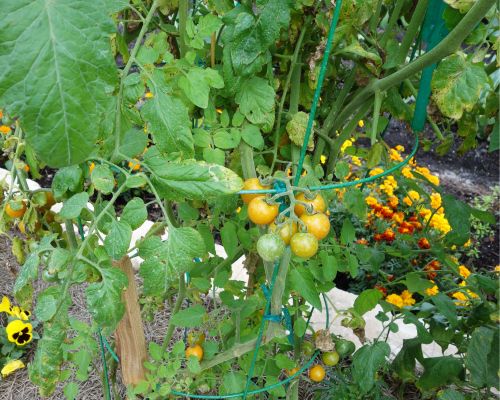Gardening Through Climate Change
Share
If full-blooming crocuses and still-thriving kale at the end of February in New England aren’t signs of climate change, then this definitely is: 2023 was the warmest year in the modern temperature record. And it’s not just the temperatures that are changing. Weather patterns that were once stable are now all over the map. Heat waves and drought in Oregon? Tornadoes in Massachusetts? It’s hard to garden in the heat, and it’s even harder when you can’t predict what the weather will throw at you next.
It’s not all doom and gloom, though. Stay with us here, because we do have some suggestions as to how you can counter some of the adverse impacts of climate change. It’s doable, especially when our communities come together and employ these practices. But first, we need to understand some of the impacts our changing climate has on our gardens.
Climate Change’s Impact in the Garden
Without a doubt, climate change is impacting our gardening and all of agriculture. As one piece of evidence for that, the U.S. Department of Agriculture adjusted its Plant Hardiness Zone Map in 2023 to take into account longer growing seasons and increased temperatures. In fact, if you input a ZIP code on the Map’s page, it’ll respond with the average temperature adjustment for the map since it was last updated in 2012. Not all locations changed, and some of the changes can be attributed to more data points added to the average low temperature calculations. So, some good news there.

Let’s dive in to some of the ways climate can change our gardening efforts.
Longer Seasons
To some extent an earlier start and later end to your gardening season is a perk you might be excited about. More blooms and more bounty, right? However, think about how plants flowering earlier than usual might end up being out of sync with the bees, moths and butterflies that pollinate them. Beneficial insects could also become out of sync with their prey, allowing those pest populations to grow—and munch on your garden—unchecked. These complex connections could unravel thanks to earlier and longer seasons, putting both flora and fauna at risk.
Warmer Temperatures
There are several implications to having above-average temperatures. The first is that a warmer regional climate may usher in non-native and invasive plants and insects, replacing populations that evolved for that specific climate. Another implication is that warmer temperatures could prohibit the growth of species and agricultural crops in areas where they’ve long existed. Also, landscapes and crops dealing with warmer temperatures will use more water. Pair that with less rainfall in some areas and that becomes a problem.
Drought, Pests, and Diseases
Prolonged drought and near-drought conditions will lead to gardens and landscapes that experience stress and weak growth. This weakened state leaves the plants vulnerable to pests and diseases, the impacts of which lead to further stress.
Soils
The root cause of climate change is too much carbon in the atmosphere. Our soils, which store carbon as carbon dioxide and organic matter, are one source of that carbon. When soils are tilled, land deforested and wetlands removed, the carbon they contain is released into the atmosphere. A warming climate can also dry out soils, which impacts the health of the soil microbiome and leads to soil erosion.

Climate-Resilient Gardening
Fear not! You do indeed have a long and prosperous gardening life ahead of you. It may look a little different from what you have been doing, but that’s okay. Work with what the changing climate is giving you, and in the process you and gardeners worldwide may become an important component in the work of slowing the rising global temperatures.
Here’s what you can do:
Plant natives. Natives have never been so popular—just ask Izel Plants!—and they’ve also never been so important. These species are well-suited to your region, and as such are primed with resiliency to adapt to its changing environment. They will also help create a defensive line to slow the spread of invasive species.

Plant trees. Trees absorb carbon dioxide from the atmosphere, acting as a carbon sink. On top of that, if shade trees are planted near a building, they help to keep the building cool and reduce dependency on air conditioning systems.
Use water-wise practices. Use rainwater collection systems, employee drip or spot irrigation techniques, and apply mulch to slow evaporation.

Choose your crops carefully. Use crop varieties that have been bred for heat and drought tolerance and disease resistance. Use companion planting techniques to reduce weeds and maximize space.

Compost! Create your own compost from yard and kitchen waste. This reused material will add nutrients to your soil (thereby reducing chemical inputs), improve soil aeration, and feed your soil’s microbiome. If you can’t compost at home, replenish your plant’s soil with our Planting Mix Compost Blend!

Use Biochar. Our Biochar Blend not only permanently adds carbon back into your soil, but its other great components (compost, worm castings, alfalfa and kelp meals, and a load of other nutrients) combine to improve plant health and your crop yields.

Advocate for community gardening. The above suggestions are a great way for individuals to start making an impact. Imagine the power of these techniques when dozens of your community members join in? Community gardens and parks with their bigger footprints provide more opportunities for tree growth, carbon storage, plant biodiversity and healthy soils.
Resources
Ask your local Cooperative Extension for information about best gardening practices in the face of climate change. They’ll have tips and techniques that are specific to your region’s challenges. Other resources that you may find helpful include:
- National Wildlife Federation’s Gardening for Climate Change
- UC Marin Master Gardeners’ How Climate Change Affects Your Garden
- University of Maryland Extension’s Sustainable Gardening: Solutions to Climate Change
- University of Maryland Extension’s Improve Soil Health for a Climate-Resilient Garden
- USDA Unveils Updated Plant Hardiness Zone Map
- 2023 USDA Plant Hardiness Zone Map



